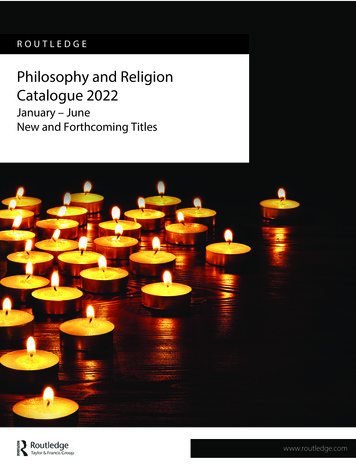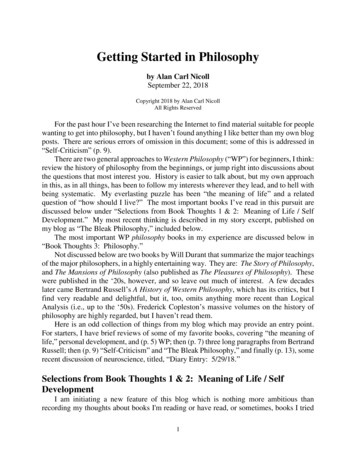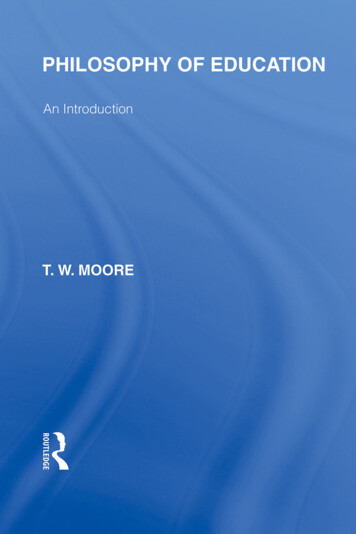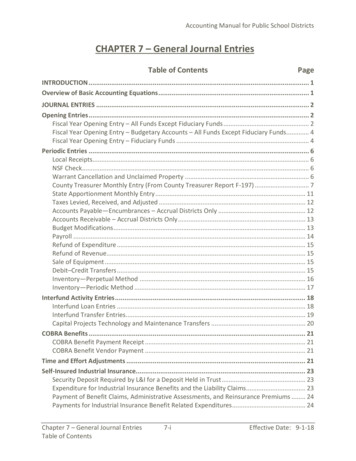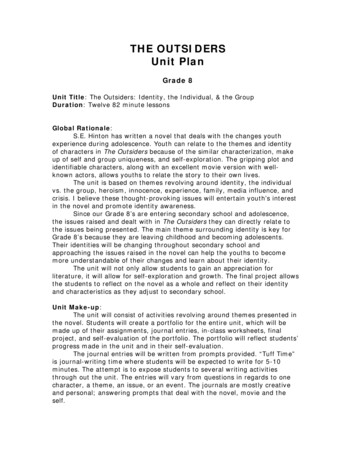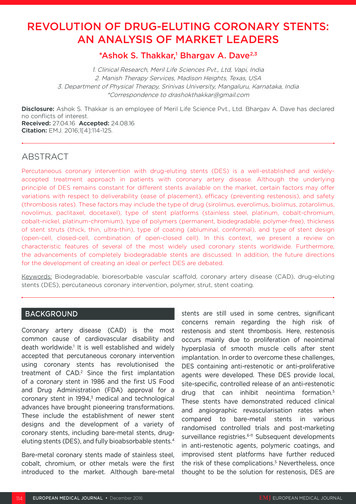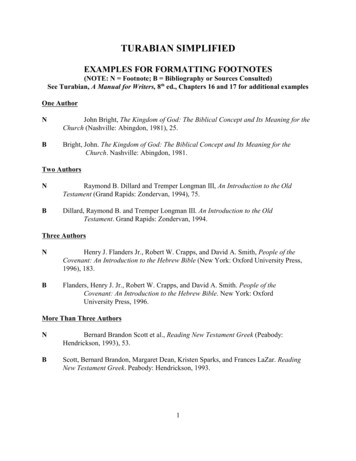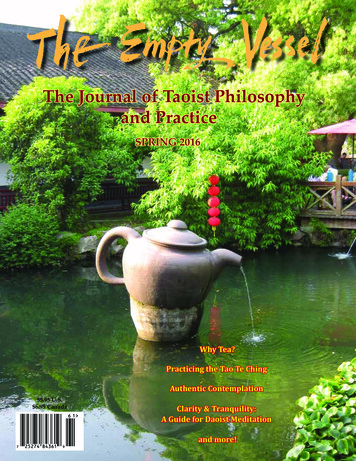
Transcription
The Journal of Taoist Philosophyand PracticeSPRING 2016Why Tea?Practicing the Tao Te ChingAuthentic Contemplation 5.95 U.S. 6.95 CanadaClarity & Tranquility:A Guide for Daoist Meditationand more!The Empty Vessel
ENERGY ARTS online classesgo Beyond the ordinary The Five Keys to Taoist Energy ArtsDragon & Tiger Medical QigongOnline ProgramOnline ProgramTaught bySenior Instructor Paul CavelTaught BySenior Instructor Bill RyanThis 10-week online program will help you systematically build a solid foundation for learning Taoistmeditation and energy arts, including qigong, tai chiand bagua forms. You will learn some of the most important neigong or internal energy components thatsupercharge these arts. Mastering these five keys willenable you to advance rapidly.Dragon and Tiger Medical Qigong is one of the mostpowerful and accessible healing systems to emanatefrom China. As a superior low-impact health maintenance exercise grounded in spirituality, it is an excellent practice to directly feel and move chi in yourbody.Five essential exercises, which Paul calls the “Five Keys,”can be practiced alone or in tandem with other keys toboost the benefits of Taoist Energy Arts training.The Five Keys are: Taoist whole-body breathing Standing qigong, including sinking qi and outerdissolving Dragon and Tiger Qigong Movement 1 Cloud Hands neigong(Opening the Energy Gates Practice)In this 10-week online program Bill will provide indepth instructions so you can: Learn all seven movements with precisealignments Work with the chi of your acupuncturemeridian lines Clear out blockages and energeticallycleanse the body Create a regular daily practicerhythm that will carry over intoyour everyday life Bonus lessons by Bruce Frantzis! Tai Chi Circling Hands Bonus lessons by Bruce Frantzis!Sign up for your online class today, visit www.energyarts.comFounder of Energy Arts, Bruce Frantzis is a Taoist Lineage Master with over 40 yearsof experience in Eastern healing systems. He is the first known Westerner to holdauthetic lineages in tai chi, bagua, hsing-i, qigong and Taoist meditation. He hastaught Taoist energy arts to more than 15,000 students. Frantzis trained for overa decade in China and also has extensive experience in Zen, Tibetan Buddhism,yoga, Kundalini, energy healing therapies and Taoist Fire and Water traditions.ii151231 EmptyVessel DT5K.indd 1Spring 201612/31/2015 7:23:57 PM
A Book to Guide the WayDAOIST NEI GONG FOR WOMENThe Art of the Lotus and the MoonRoni Edlund and Damo MitchellAvailable in the written form for the first time, the specificpractice of Nei Gong for women is explained in this book.Maximising the potential of the female energetic system, RoniEdlund and Damo Mitchell present teachings that make NeiGong far more effective for women that the male-orientedmethods usually taught. 24.95978-1-84819-297-3DAOISTMERIDIAN YOGAActivating the TwelvePathways for EnergyBalance and HealingCamilo Sanchez, L.Ac, MOM 25.00978-1-84819-285-0PAPERBACKCHA DAOThe Way of Tea,Tea as a Way of LifeSolala Towler OMPAPERBACKDAOIST NEI GONGThe Philosophical Artof ChangeDamo Mitchell 24.95978-1-84819-065-8PAPERBACKWHITE MOON ONTHE MOUNTAINPEAKThe Alchemical Firing Processof Nei DanDamo Mitchell 39.95978-1-84819-256-0PAPERBACK
ContentsSpring 2016 Volume 23 Number 32Clarifying the Difference Between Neidan, QiGong, and Visualization in Daoismby Robert James Coons59131823Practicing the Tao Te Chingby Solala TowlerThe Empty Vessel Interview withDr. Zhi Gang ShaWhy Tea?by Wu DeAuthentic Contemplationby Wu Jyu CherngDepartmentsClarity & Tranquility: A Guide forDaoist Meditationby Stuart Alve Olson1Along the Way28Reviews33Directory
What is Taoism (Daoism)?“The Tao (Dao) that can be described is not the eternalTao.” So begins the Tao Te Ching (Daodejing) of Lao Tzu (Laozi)written some 2,500 years ago. How then, to describe theindescribable? How to fit into words that which is beyondwords? The Tao can only be pointed to, or referred to, say theancient sages. It cannot be held, only experienced. It cannotbe touched, only felt. It cannot be seen, only glimpsed withthe inner eye.Tao, then, is the Way, as in direction, as in manner, source,destination, purpose and process. In discovering and exploring Tao the process and the destination are one and the same.Lao Tzu describes a Daoist as the one who sees simplicity inthe complicated and achieves greatness in little things. Heor she is dedicated to discovering the dance of the cosmosin the passing of each season as well as the passing of eachprecious moment in our lives.Taoism was already long established when Lao Tzu wrotethe Tao Te Ching. It originated in the ancient shamanic rootsof Chinese civilization. Many of the practices and attitudestoward life were already established before Lao Tzu'’s time.For many centuries Taoism was an informal way of life, away followed by peasant, farmer, gentleman philosopherand artist. It was a way of deep reflection and of learningfrom Nature, considered the highest teacher. Followers ofthe Way studied the stars in the heavens and the energy thatlies deep within the earth. They meditated upon the energyflow within their own bodies and mapped out the roads andpaths it traveled upon.It is a belief in life, a belief in the glorious procession ofeach unfolding moment. It is a deeply spiritual life, involvingintrospection, balance, emotional and spiritual independenceand responsibility and a deep awareness and connection tothe earth and all other life forms. It requires an understanding of how energy works in the body and how to treat illnessin a safe, non-invasive way while teaching practical ways ofmaintaining health and avoiding disease and discomfort. Taoist meditation techniques help the practitioner enter deeperor more expansive levels of wakefulness and inner strength.But most of all, it is a simple, natural, practical way of beingin our bodies and our psyches and sharing that way of beingwith all other life forms we come into contact with.Today in China and in the West, Taoism is often dividedinto two forms, tao jio and tao jia. Or religious Taoism andphilosophical Daoism. Many scholars argue that there arenot two distinct forms of Taoism and in many ways they areright. There is really a great intermingling of the religiousform of Taoism and its various sects and the philosophicalTaoism of Lao Tzui and Chuang Tzu (Zhuangzi). But manypeople who follow the Tao do not consider themselves religious people and do not go to temples and are not ordainedas priests. Rather these two forms exist both side by side andwithin each other.It is up to each of us to find the way to the Way in our ownway. What we try to do with The Empty Vessel is offer articlesand information to help you, our dear readers, to do that.The Empty VesselThe Journal of Taoist Philosophy and PracticePublisherThe Abode of the Eternal TaoEditor and DesignSolala TowlerContributing EditorKurt Levins Sr.Copy EditorShantiThe Empty Vessel: A Journal of Contemporary Taoism ispublished quarterly by The Abode of the Eternal Tao,1991 Garfield Street, Eugene, Oregon 97405.E-Mail address: solala@abodetao.com.Web site: www.abodetao.com.Subscriptions are 24per year (U.S. funds).Digital version is 20 per year. Please see our websiteunder Store to order subscriptions. 2016 by The Abode of the Eternal Tao, all rightsreserved. The Empty Vessel is not responsible for opinions or statements expressed by authors or for advertisers' claims.Advertising rates are available by calling The EmptyVessel at 541.345.8854, or emailing solala@abodetao.com.Statement of PurposeThe Empty Vessel is dedicated to the exploration anddissemination of Taoist philosophy and practice. It isopen to sharing the various traditional and contemporary teachings in a nondiscriminatory manner. Weat The Empty Vessel believe that it is in using thesepractices and attitudes of the ancient achieved ones ina timely and contemporary manner that we can bestbenefit from them and in doing so, be able to effectchange in the world around us.
National Qigong Association21st Annual ConferenceFriday–Sunday, July 29–31, 2016Dolce Basking Ridge Hotel, Basking Ridge, NJ Are you. New to the world of Qigong andthe Energetic Arts? A practitioner looking to deepenyour personal practice? A healthcare professional orhealer looking to broaden thescale and scope of your practice? A teacher looking for ways toenhance both your teaching skillsand practice?The NQAAnnual Conferenceis the place for you! KEYNOTE Friday, July 29Lee Holden: Five Paths to Inner Power PROFESSIONAL TRACK Friday & Saturday, July 29–30Ted Cibik: Three Dantians; Chong Vessel & VagusNerve; Post-Natal Qi & Gut/Enteric Nervous System ENTERTAINMENT Saturday, July 30The Great Saturday Night Tao Wow PLENARY Sunday, July 31Robert Peng: The Master Key: Qigong Secrets forVitality, Love, & Wisdom Three days of workshops, lectures, seminars, and demonstrations presentedby over 20 leaders in the fields of Qigong, Taijiquan, and the Energetic Arts,plus. Networking with friends in the Qigong community Distinctive vendors & products Silent auctionFor Conference details, visit www.nqa.org. To register, call1-888-815-1893 & mention code EV716 for 10 discount.
Along the WaySpring has come, bringing with it fresh colors, scentsand warm breezes! We at the Abode are welcoming springwith open hearts. There's always so much to do when the longwinter rains stop here in Oregon. This winter was pretty warmbut very wet, which is fine because, while it has not been asbad as California, Oregon has been in a little bit of a drought.But as the ponds formed in our backyard this winter we werehappy to see them come!Springtime is associated with the element wood, as innew growing plants. It is also associated with the color green,the liver, the positive state of freeflowingness and with thepower animal the Green Dragon.It is when we are ready and able to face this direction,both inwardly as well as outwardly, that we too can becomeas new growth, as the pliable and flexible plants that Lao Tzutalks about.And speaking of Lao Tzu, my new book Practicing theTao Te Ching: 81 Steps On the Way, is now out with mywonderful publisher Sounds True (see exerpt on page 5.) Thisis my attempt at presenting the Old Boy's work as a manualfor self cutivation. It was the biggest, hardest, most rewardingwriting project that I have ever done, but well worth it!Most people only know the Tao Te Ching as a book ofphilosphy but it was actually written as a manual for spiritualcultivation, with many practices written into the text, if youknow how to read it. So my version has a practice for each ofthe 81 chapters, many of which come directly from the textand others from other Taoist traditions.The other exciting writing project that I have beenworking on is a book called The Spirit of Zen, which willbe published by my London publisher Watkins, the oldestesoteric publishing house in England. It is a collection of wildand wooly teaching stories from both Chan and Zen sources. Itis similar to my book Tales From the Tao, as it is also heavilyillustrated with beautiful nature photos printed in black andsilver on glossy paper so that they have a kind of 3D effect. Notonly that but this time all the photos are mine! The Spirit ofZen will be out this winter.I will be doing a lot of traveling and teaching around thecountry this spring and summer, serving gongfu tea and teaching taoist philosophy and practice (called pin ming lun dao or“savor tea, discuss dao.” ) and teaching Wuji Qigong. Pleaserefer to the listing on page 27 or check my website at www.abodetao.com for updates.We are also taking reservations for our annual China Qigong Training Tour in October. We will be working with a localmaster in Wudang Mountain, my favorite place in China! (Seead on page 4 for more info about this or go to our website atwww.abodetao.com.) We will also spend a littletime in Hangzhou, my favorite Chinese city aswell as a few days in the ancient capital, Beijing,at the end of the tour.Subscribe toand receive four issues of Insightful and stimulatinginterviews with contemporary Taoistmasters and teachers Informative and inspirational articles on Taoist philosophy and practice. Reviews of the latestbooks & DVDs.Subscribe now for only 24 for oneyear. (U.S. funds please.)or subscribe to our on-line versionfor only 20 atwww.abodetao.comBegin my subscriptionwith the next issueNameAddressCityStateSolala Towler, editorThe Empty VesselZip(Add 15 for postage outside the U.S.)Abode of the Eternal Dao1991 Garfield StreetEugene, Oregon 97405541.345.8854www.abodetao.com1
Clarifying the Difference Between Neidan, QiGong, and Visualization in DaoismRobert James Coons“The Dao is in the centre!Confucianism says to focus fully (on the) centre,Daoism says to protect the centre,Buddhism says (to) empty (the) centre.The opening in the centre of the opening is the true openingof the centre.”- Zhang Sanfeng.Daoism is an ancient practice, and since its inception roughly2500 years ago, it has undergone many changes in idea, principle,and practice.Ancient Daoists were interested in using research of the worldto understand the self, and using understanding of self to lengthenlife and cast off the mortal shell of the suffering world.Daoism is not just one school, but many schools, each withtheir own ideas about how to achieve union with the universe andlasting peace and prosperity of spirit.As such, Daoism has had many types of practice and each ofthem has a root in the investigation of the Dao. These practicescome from different regions of China, different types of experience,and oftenbuild historically on each other in order to ultimately be.passed down as completely thought out, and powerful methodsof self cultivation.In the Western discourse on Daoism, it is very common toknow about Qi Gong, Taijiquan, and Internal Alchemy (Nei Dan),but it is not so common to clearly understand their origins andrelationship to each other.Because of my unique luck in finding legitimate teachers ofDaoist methods, martial arts, Qi Gong, and several other “Daoist”health cultivation disciplines in Asia and North America, and myyears of working hard to research Daoist meditation in a nonsectarian fashion, I have been able to come to an understandingof some important historical and cultural currents that act asanchors to our Daoist practice. Today I hope to share a little withyou about the connection between Daoism, Nei Dan, Qi Gong, andVisualization based meditation here.To begin, Daoist methods start with Laozi and Zhuangzhi, andalthough it is likely that Daoist communities existed before eitherof them wrote their books, the most important early treatises ofDaoism are still by these two. Both Laozi and Zhuangzi suggestedfocusing on quiet as a way to nurture life. The Theory was laterexplained by the Neo Confucian scholar Zhu Xi as being the use ofthe deepest state of Yin energy to give birth to the purest state ofYang energy. Yin and Yang, of course are the feminine and masculine energies of the universe and in our body are personified as thePo (female soul) and Hun (male soul). Laozi said that we should“protect the feminine,” and emulate the emptiness of the sky.Laozi also said to “focus the breath on absolute softness and2Spring 2016
become like a child,” so it must be inferred that early Daoists alsounderstood the method by which foetuses come to develop inthe womb, seemingly from nothing, and develop as a type of purepositive energy during gestation.This type of practice was carried on by the Tianshi Daoistcult of Zhang Daoling, but by the early middle ages of the Tangand Song dynasty, Daoism also began to develop other typesof practices which were different from the ancient principle ofcultivating the feminine and absolutely softening the body. Ancient documents such as Huang Ting Jing (Yellow Palace cCassic)instruct us how to perform various visualization techniques thatcan be used to develop the strength of the organs of the body andachieve “long life.” During the three kingdom period and theTang dynasty, visualization had become the major part of Daoistmeditation practice, and also accompanied external alchemy andvarious types of liturgy and yogas designed to help people becomespiritually enlightened and join with the deities of the Dao. Visualization practice in Daoism can be very complex or very simple,but in general, visualization is done for specific purposes. Somepopular visualization exercises of the time were to imagine a foetusabove the head, wrapped in a purple cloud, and gradually bring thefoetus in to the body through the head until it reached the abdomen, or simply to imagine a foetus developing and breathing inthe abdomen (this exercise is from Ge Hong’s famous book “TheEmbryonic Breathing Classic”). While these exercises are verypowerful, they can also lead to many problems, since visualization if not carefully taught, can lead to misunderstandings of thestyle and intensity of the practice. It is not enough to simply readvisualization classics, they must be taught by a competent teacher.Around the end of the Tang dynasty, there was a rift in Daoistthinking with the arrival of Lu Dongbin, a sage who encouragedthe practice of Golden Elixir. This method used quiet observation and the utmost focus on yin energy and the centre of thebody (the lower dantian/golden palace) to produce “qi” energyin the body. After enough time and practice, this Qi energy couldconvert into elixir and fortify the human spirit, allowing one totranscend mortality and become a heavenly immortal (at least inthe perspective of Daoists who practiced at that time in history).This type of practice was mastered by Zhang Boduan, thefounder of the Complete Reality Sect, who even went so far as tosay “bending and stretching the body, and swallowing rainbowsis not the real way of the Dao.” This comment is in regards tothe Daoyin yogic practices of earlier Daoism, and in fact is a totalrejection of the value of stretching the body and using physicalfortification to achieve immortality. Zhang also echoed Lu’s assertion that the best kind of immortality is heaven immortality.Lu Dongbin was of the opinion that there were five major typesof immortality, with the heaven method being the only one thatcould stop people from continuing the reincarnate on the wheel ofearthly suffering. Lu compared the low level practices of Daoistsand Buddhists of his day to the achievement of a ghost. A ghostimmortal is a person who has cultivated yin energy enough thattheir spirit does not die with their body, but is forever trapped onearth as a sickly, weak ghost, unable to reincarnate. Lu believedthat this level of practice was very difficult to become free fromand should be avoided. This type of ghost practice is still verycommon in the new age community all over North America andEurope and represents what Zhang Boduan called “not asking forthe Dao, you will only be lost on the road.”The rift between the practice of elixir and the earlier practices of visualization, external alchemy, and Dao yin represent theThe Empty Vesselmaturation of Daoist ideas, and the return to Laozi’s concept ofquiet stillness, non action, and nurturing the feminine in order tocultivate the masculine.This practice was very effective and carried on in Northernand Western China for many centuries, while the older, more liturgical and physical practices of Daoism were maintained morein the South of China by the Zhengyi sect and earlier groups suchas the Lingbao and Sanqing, among others.Quanzhen methods went on to be combined with Buddhistand Confucian ideas, and schools such as the San Feng school andthe Middle school are purely based on Nei Dan meditation, usinga non sectarian approach to showing the similarities of the threebig Chinese religions.These schools went on to have great impact on 20th centuryDaoist scholars such as Chen Yingning and Jiang Weiqiao, whosuggested that the real goal of Daoism was to cultivate healthand happiness, rather than focus on the religious ideologies ofearlier Daoism. Or course, religious Daoist ideas also continuedto prevail as the official voice of Daoism, and the 20th centuryhealth ideology ultimately simply became part of Chinese popularculture, and is practiced by many people who would not normallyclassify themselves as “Daoist.”During the 20th century period, ancient Daoist yogic exerciseswere revisited in order to compile exercise routines for the common people, in order to “strethen the nation.” Ancient visualization pracices were also rethought in order to formulate what wenow commonly refer to as “Qi Gong.”Although the visualization of Qi Gong is typically not ascomplex as the visualization practices of the southern schools ofDaoism, they still retain the general idea of these techniques, andare in fact much closer to ancient “cun xiang,” visualization thanthey are to Nei Dan meditation.Because the historical tangent of Daoist practice is not wellunderstood outside of China, it has made it very easy for unethicalpeople to market false and useless practices as Daoist. Regardless of whether someone simply rebrands their Qi Gong practiceas Nei Dan, or simple stretching as Qi Gong, or if they undertakemuch more harmful practices such as sucking the testicles insidethe body, extreme breathing accompanied by heavy visualizations,or other practices that go against Laozi’s way of gentle cultivationof the feminine, many evil teachers intentionally teach studentsmethods that go on to injure them.Regardless of whether we want to practice Qi Gong, visualization, or Nei Dan, we should all take our understanding from Laozi,who said “quiet the heart, fill the belly, soften the will, strengthenthe bones.”This is the real way of Daoist practice and produces the bestresults. Qi gong, visualization,and Nei dan, although being verydifferent, come from the same root.The root is quiet, and thenquiet, calm, and then calm, dark, and then dark, and is the gate tounderstanding all that is subtle and wonderful.Robert James Coons lives in Shanghai China where he researchesand writes freelance about Chinese culture and its connection toDaoist thought. Having started his training in Daoism in Canadawith master Yang Hai in Montreal, he has further gone on to studytea ceremony, Chinese classical music, martial arts, dance, andChinese incense culture. He is currently writing a book explaining the connection between the Dao De Jing and spiritual practice,as well as operating a small tea business based out of Toronto.3
Empty Vessel China Tour 2016 with Solala TowlerHangzhou Wudang Shan BeijingOctober 12 -28, 2016Join us in May when we travel to the sacred mountains of Daoism. We will visit Wudang Shan – home of Daoist taiji,qigong and martial arts. We will spend days hiking and visiting some of the many Daoist temples there, attend classeswith a local master, drinking tea in the temple teahouse and practice Wuji Qigong, a 600-hundred year old qigong form,created by the famous Wudang Daoist master Zhang San Feng. We will also be visiting Qingcheng Shan, an ancientDaoist mountain. outside of Chengdu (home of the best food in China!). We will doing some training with an abbessat a temple there plus spending time hiking the many beautiful trails up the mountain.We will also be spending time in Hangzhou, one of the most beautiful cities in China. Hangzhou, circling around WestLake, has long been revered for its beauty and culture. While there we visit a tea plantation (where the famous DragonWell tea is grown), as well as the museum of Chinese Medicine and take in an awe-inspiring lake show by Zhang Yimou,the well-known Chinese film director, called West Lake Impressions (check it out on youtube).The last few days will be spent in Beijing, where we will visit the White Cloud Temple, the Great Wall and the fabuloustea market as well as attend some amazing acrobat shows. All along the way we will eat amazing food, meet qigongmasters, artists, musicans, tea masters, and one cave dwelling hermit.17-day China TourPer person: 4300Single room supplement: 400Credit card payment available(Price may be subject to change.)What’s included: Roundtrip airfare from U.S. to China All hotels double occupancy Study tuition Meals Excursions and sightseeing Translation All bus, train and air transportation within China“Thank you so much for planning such a perfect trip for us.”“Thanks again for organizing such an amazing trip. I had a fantastictime and will never forget it.”For a full itinerary call or write:The Abode of the Eternal m4Spring 2016
Practicing the Tao Te ChingSolala TowlerStep 3Not praising the talented prevents jealousy.Not storing up riches prevents stealing.By not displaying valuable thingspeople’s hearts are not troubled.This is why sages empty their heart-mindsand fill their bellies (dantian).They weaken their ambitionsand strengthen their bodies.They are free of knowledge and desires.By practicing not doing (wu wei)they live in peace and inner harmony.The CommentaryThis book is designed to offer the teachings of Lao Tzu as a manualfor self cultivation, a journey of 81 steps to wholeness and return toSource, to Tao. In this way, each chapter of the text is offered froma Taoist persective, along with in depth commentary followed byan actual practice, many taken directly from the text and othersfrom other Taoist traditions. Here is a little taste of this book.The Empty VesselIn this step, Lao Tzu tells us how to avoid pangs ofjealousy over how much other people are accomplishing, which cause us to feel inferior. This step buildson the previous description of the sage as one whoaccomplishes, but does not become attached to his accomplishments. Ho Shang Kung says, “Do not contendfor merit and glory but return to nature.”1 In today’sconsumer society, we are often judged by how muchwe produce or by how much we consume, yet if weconsume or own too much, we become paranoid thatsomeone will take things away.The next part is an extremely important antidote tothis and is usually mistranslated: it refers to the practiceof meditation or “empty mind” practice. To Taoists, ourmind resides in our heart. The written character forheart is xin, which is where both our cognitive mindand our shen (spirit) live. Shen is our spiritual energyas well as our creative energy and includes our thoughtprocesses. To “empty the mind” is one goal in stillness,or meditation, practice. Lao Tzu will return to this ideain later steps. When Lao Tzu says “fill their bellies,”he does not mean that the sage is constantly eating!Instead, it refers to the lower dantian. Dantian, whichmeans “field of elixir” or “field of medicine,” is wherethe internal alchemy practices called nei dan begin. There arethree dantians: one in our lower abdomen called the Jade Pond,a little below our navel and a third of the way inside our body;the middle dantian, called Red Palace, is located in our heartcenter; and the upper dantian, called the Heavenly Center, is5
THE PRACTICEFilling the Jade PondBy working with energetic practices like this one, ourenergy becomes increasingly subtle — ultimatelyleading to union with the subtle source of all life, Tao.Although our minds reside in our hearts, many thoughtprocesses leave us stuck in our heads. Energetically,we end up with gigantic heads and no bottom. In thispractice, we are taking the fire of the mind and puttingit under the water of the lower dantian. By putting ourmind-intent here, our energy will naturally flow downward, and we will become more balanced. Sit quietly on the edge of a chair or on a cushion.Close your eyes and breathe slowly and deeplythrough your nose. Your breathing should be solight that a feather held in front of your nose wouldnot move. This will take some time, so go slowly,without worry. With each inhalation, feel your lower dantian expand. On each exhalation, feel your lower abdomencontract. This is the type of breathing you did inthe womb, when you were breathing through yournavel. Put your mind-intent down into your lower abdomen. Don’t try to make anything happen, just let theenergy flow downward naturally. Eventually, youmay feel some heat or tingling in this area, thoughthat may not happen for some time. Just stay withthe practice, and things will move when they areready. For a healing effect, use your mind-intent tobreathe in healing light on each inhale. Feel it entering your whole body, burrowing down to the darkplaces in your energetic or physical body, where anydisease, pain, or toxicity exists.found in the center of our brain, or our third eye point. Thelower dantian is associated with the prostate or ovaries, whilethe middle dantian is associated with the thymus gland, andthe upper dantian is associated with our pineal gland.The lower dantian, referred to in this verse, is our body’senergetic foundation. Just as a house needs a strong foundation,we need to build up our energy in this all-important center.The lower dantian is associated with the element water. So the“cooking” or “alchemic” practice described in this step involvesputting the “fire” of the heart-mind down below the “water” ofthe lower dantian. The fire of the intellect, unless it is properlytrained, will consume us with endless thoughts and thoughtsabout our thoughts and so on, leading to exhaustion, or worse.The interaction of the fire (li) of the mind and the water (kan)of the lower dantian creates steam, or new chi. This is thenfurther cultivated until it is transformed to pure spirit, or shen.From there, the cultivation practice is to transform shen backto wuji, or the “primordial origin,” and ultimately to Tao. On each exhale, see all the disease, pain, or toxici
Dragon and Tiger Medical Qigong is one of the most powerful and accessible healing systems to emanate from China. As a superior low-impact health mainte-nance exercise grounded in spirituality, it is an ex-cel

